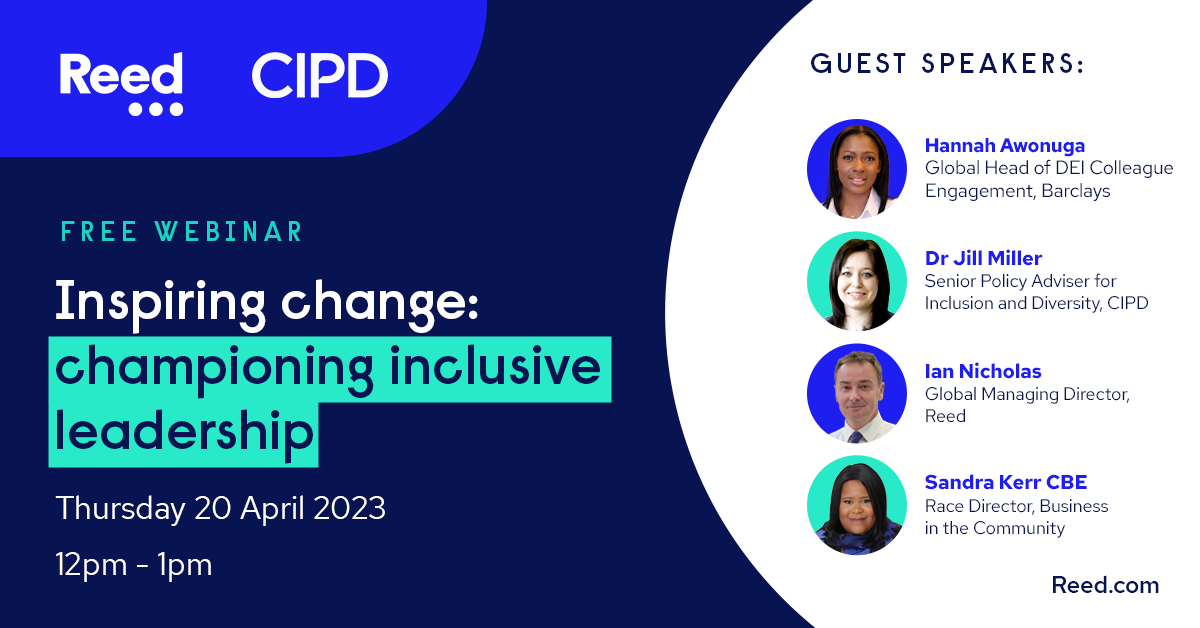Watch the webinar

Leaders have a central role to play in creating a fair, inclusive, and diverse organisation with equal opportunities for everyone, regardless of their background, identity, or circumstance.
At the end of 2022, Reed partnered with the CIPD to produce ‘Inclusion at Work 2022’, a survey report that highlighted the need for companies to focus their approach on inclusion and diversity (I&D) in the workplace.
23% of respondents agreed that senior leaders feel uncomfortable talking about inclusion and diversity.
23% of the senior decision-makers agreed with the statement that senior leaders wrongly believe they already have an inclusive and diverse organisation.
22% of leaders still don’t understand how an inclusive workplace and diverse workforce can benefit the organisation.
21% of employers agreed that senior leaders just pay lip service to I&D in their organisation.
Tangible action on inclusion and diversity is part of how senior leaders’ performance is judged in 29% of organisations.
On the back of the report, Reed’s Global Managing Director, Ian Nicholas, Jill Miller, Senior Policy Adviser for Inclusion and Diversity at the CIPD – author of the report, Hannah Awonuga, Global Head of DEI Colleague Engagement at Barclays, and Sandra Kerr CBE , Race Director at Business in the Community, dissect the key leadership findings of the report and outline what leadership teams can do to create a more inclusive and diverse workplace.
Our panel
Hannah Awonuga, Global Head of DEI Colleague Engagement, Barclays
Hannah is the Global Director, Head of Colleague Engagement within the group DEI function at Barclays. Hannah has been working in banking since she was 17 years old, and for the past 11 years has spent time leading remote teams in the retail bank, business, and corporate bank, before transitioning into diversity and inclusion.
She is also a multi-award-winning DEI thought leader and speaker. Over the past two years, she has won the 2021 WeAreTheCity rising star award, was named among the 2021/2022 most inspirational diversity and inclusion professionals by D&I leaders and was listed in the 2021 top 25 most influential DEI practitioners by HR Magazine.
Hannah was recently appointed as a non-executive director for the UK government membership body ‘Progress Together’ which has been set up to increase socioeconomic diversity at senior leadership level across the UK financial services.
Dr Jill Miller, Senior Policy Adviser for Inclusion and Diversity, CIPD
Jill is a Senior Policy Adviser for Inclusion and Diversity at the CIPD. Her work focuses on the areas of gender, age and neurodiversity and she has recently led work on race inclusion. Earlier in her career, Jill specialised in employee wellbeing and small business growth through good people management.
Her role is a combination of rigorous research and active engagement with policymakers, academics and HR professionals to inform projects and shape thinking on key inclusion and diversity issues. She frequently presents on people management issues, leads discussions and workshops, and is invited to write for trade press as well as offer comment to national journalists.
Jill joined the CIPD in 2008. She has a BSc in Psychology, MSc in International Business and obtained her PhD in Management, examining the effect of the informal organisation on performance, at Reading University.
Ian Nicholas, Global Managing Director, Reed
Ian joined Reed in 2004 as human resources director (HRD) of one of its businesses, and he also opened and ran a specialist HR recruitment arm. In 2007, when Reed merged its recruitment businesses, Ian was appointed as HRD for the newly formed Reed Specialist Recruitment.
In 2013, while retaining his HR responsibilities, he was appointed as managing director for RSR managed services and during a two-year period of successful growth he led the re-shaping of the business into what is now known as Reed Talent Solutions. It was in 2015 that Ian was appointed chief human resources officer with responsibility for all people strategies across the Reed Group and in 2017 he was appointed to the Reed Global board.
In 2020 he became the Global Managing Director for Reed, as well as a chartered fellow of the CIPD.
Sandra Kerr CBE , Race Director, Business in the Community
Sandra works together with business leaders and government policy makers to influence action on race in the UK. The Race at Work survey in 2015 with 24,457 responses and in 2018 with 24,310 responses provided the evidence to establish the Race at Work Charter announced by the then Prime Minister which now has more than 500 employer signatories.
In 2012, Sandra was awarded an OBE in the New Year’s Honours List for Services to Black and Minority Ethnic People. On the back of this, Sandra was awarded a CBE in the Queen’s Birthday honours list in 2019 for Services to Equality and Diversity, before publishing the Race at Work Black Voices Report in August 2020 and the Race at Work Charter 2020 report in October 2020.



